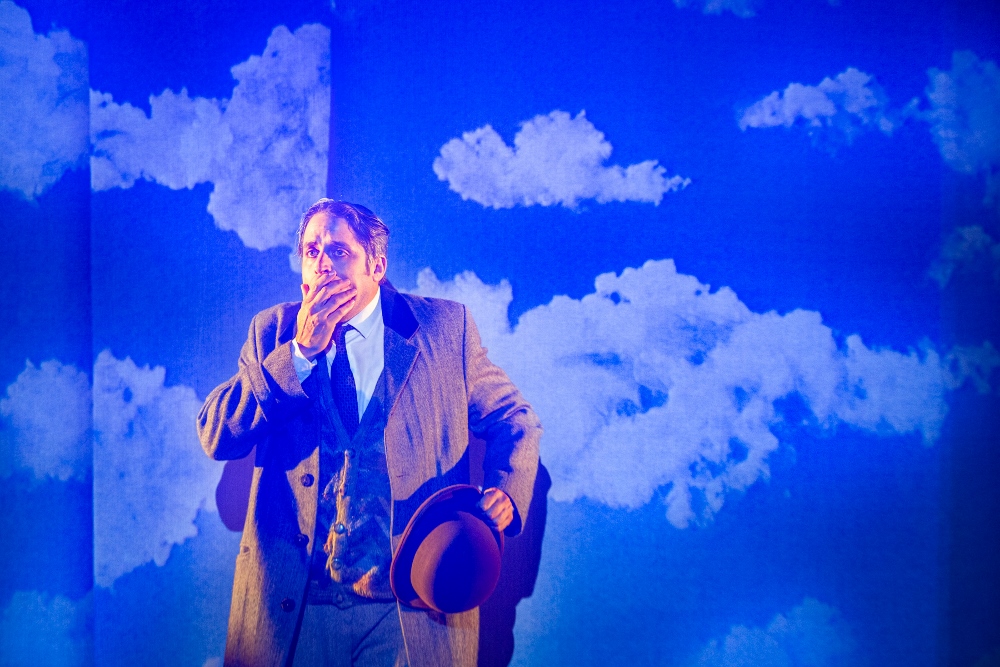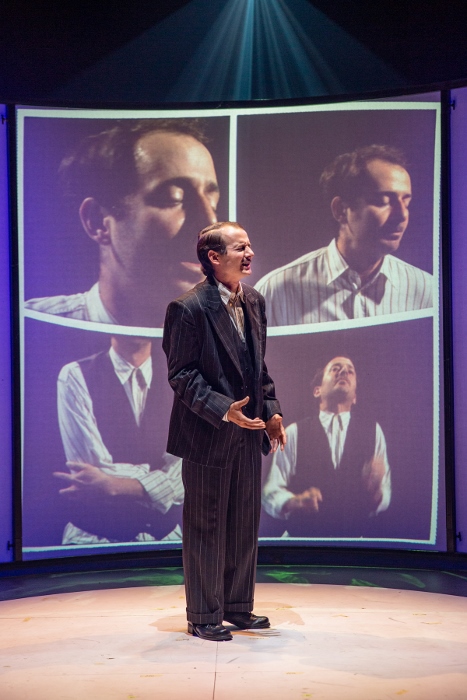
L’Homme Qui is an unusual play, thought-provoking and profoundly moving. An investigation of the brain, it is an adventure in intellectual curiosity that in its pursuit, illuminates and celebrates the mystery of the human mind. Written by Peter Brook and Marie-Hélène Estienne, its full title, translated into English is – The Man Who: a theatrical research. The term “research” is relevant on several levels. The play is inspired by Oliver Sack’s The Man Who Mistook His Wife for a Hat, a narrative of his own research into the mysteries of the human mind, through his encounters with patients. Theatrically, creating a play from this material is in its essence a process of research and exploration. The play is composed of 16 scenes, each scene focusing on a different aspect of brain function, with the four actors – David Ben Zeev, Yoav Hyman, Shachar Netz, and Itai Szor – taking on different roles in each scene. There is a total absence of any traditional narrative arc or plot. To the extent that there is continuity within the play it is in the focus on research, the doctors’ exploration of the different patients’ symptoms and their underlying causes.
Yet although this parade of patients is revealed to the audience primarily through their disorders, as indicated by the heading of each scene, and although the scenes are brief, the four actors bring these men to vivid life. As they express the difficulties they encounter, the anguish and suffering, the accommodations and modifications they need to make in order to function, and sometimes, their inability to function at all – their separate experiences are united by the most critical research of all: people searching for a way to live their lives, searching for a sense of well-being, searching for happiness.
The set, designed by Polina Adamov, is minimal, effective, and expressive. A white, semi-circular screen evokes a clinical ambiance, set on a revolving circle, it allows for a seamless flow of changes in atmosphere between the different scenes with video projections (Guy Romem – Studio Insight) enhancing the effect. In the first scene a patient (Itai Szor) is surrounded by three doctors who stimulate different parts of his brain to elicit sensory memories. The patient is almost an object to be manipulated by the doctors in pursuit of knowledge. Yet as the play progresses, each encounter is not only with a different patient and different disorder, but with a different person. If at the outset one’s intellectual curiosity is piqued, as one enters one story after another, the outstanding performances of all four actors evoke our empathy for their suffering, and admiration for their courage.
The play offers much food for thought, raising philosophical questions through clinical observations. In a scene depicting visual agnosia, a disorder in which one experiences difficulty in recognizing objects, even though one’s vision is intact. Shown an image of ocean waves, the two patients describe seeing lines, or gray lines with white spots. The scene invites reflection on how we see and perceive, the mechanics, the scientific, philosophical and cultural aspects. One of the two patients (David Ben Zeev) speaks of using rhythm of movement and music to compensate for his visual impediment; an eloquent reminder that it is possible to experience the richness of life in different ways. Another patient (Shachar Netz) has a disorder that awakens memories he did not know he possessed, opening a door to his distant childhood. In this poignant scene, Netz conveys the ambivalence of the experience, in which a cure may at times also be a loss. Many scenes enfold contradictory emotions, at once strange, funny, mysterious and painful. In a wonderful scene, as hilarious as it is touching, Yoav Hyman with perfect intonation and comic timing, portrays a man whose speech is utterly garbled, yet to his own ear and perception, absolutely fine.

The human brain is one of life’s ultimate mysteries. Science and technology enable us to discover more, yet it remains endlessly elusive in its complexity. As one observes the different places of vulnerability, the manifestations of disorders are bewildering, intriguing, surprising, absurd and heart-breaking. As we probe the how and the why of the brain, we are positioned as both investigators and the object of investigation; seeking to understand and influence our own existence. In one of the play’s most powerful scenes, Itai Szor portrays a man with tics, experiencing involuntary movements and vocalizations. His performance is fascinating. One is inexorably drawn to the extreme display, yet Szor brings such sensitivity, intelligence and humor to the character, eliciting not only the viewer’s compassion, but an admiration for his resilience of spirit.
L’Homme Qui
By Peter Brook and Marie-Hélène Estienne
Based on the book The Man Who Mistook His Wife for a Hat by Oliver Sacks; Translation: Dori Parnes; Director: Gita Munte; Set and Costume Design: Polina Adamov; Lighting Design: Roni Cohen; Music: Eugene Levitas; Video Art: Guy Romem-Studio Insight; Cast: David Ben Zeev, Yoav Hyman, Shachar Netz, Itai Szor





